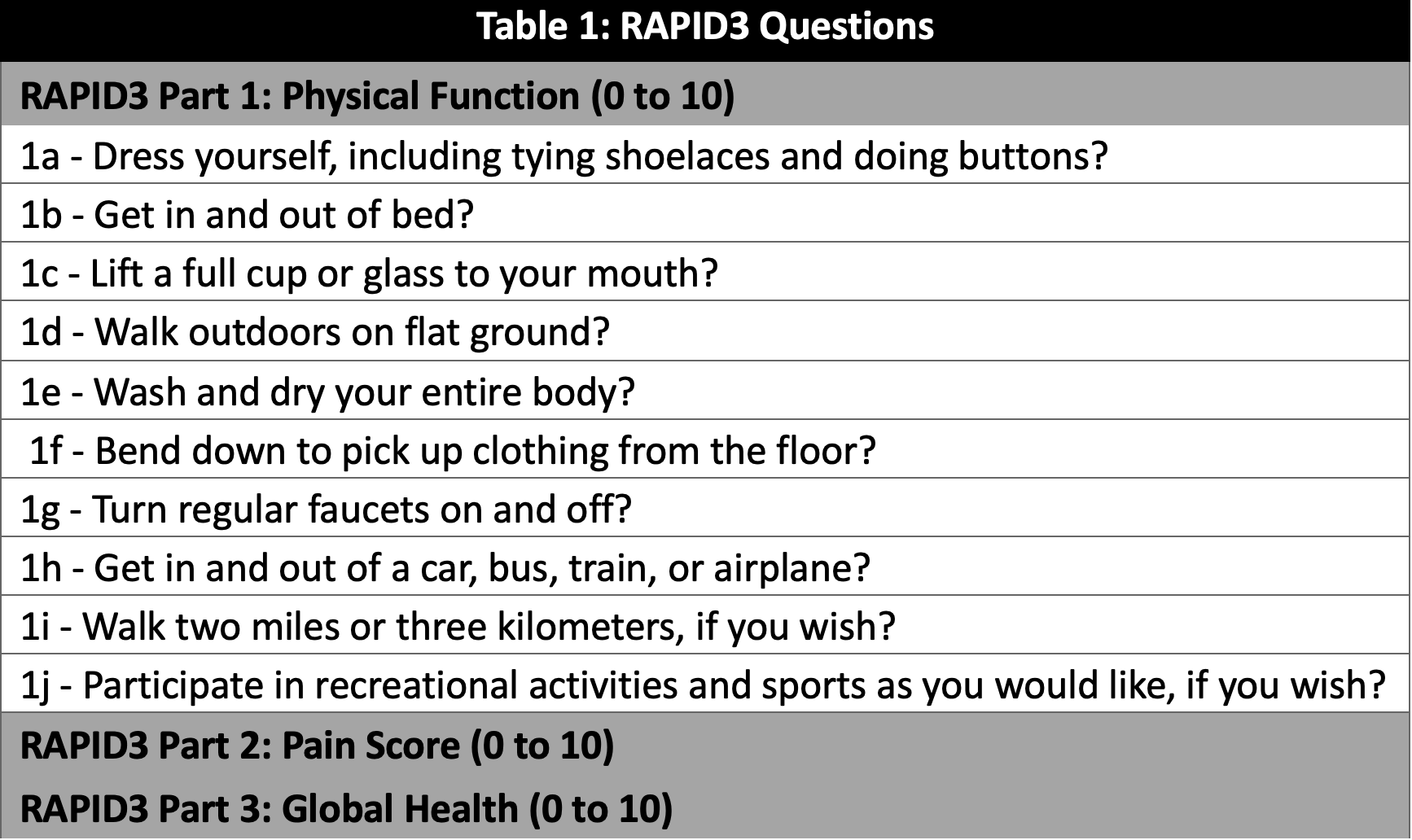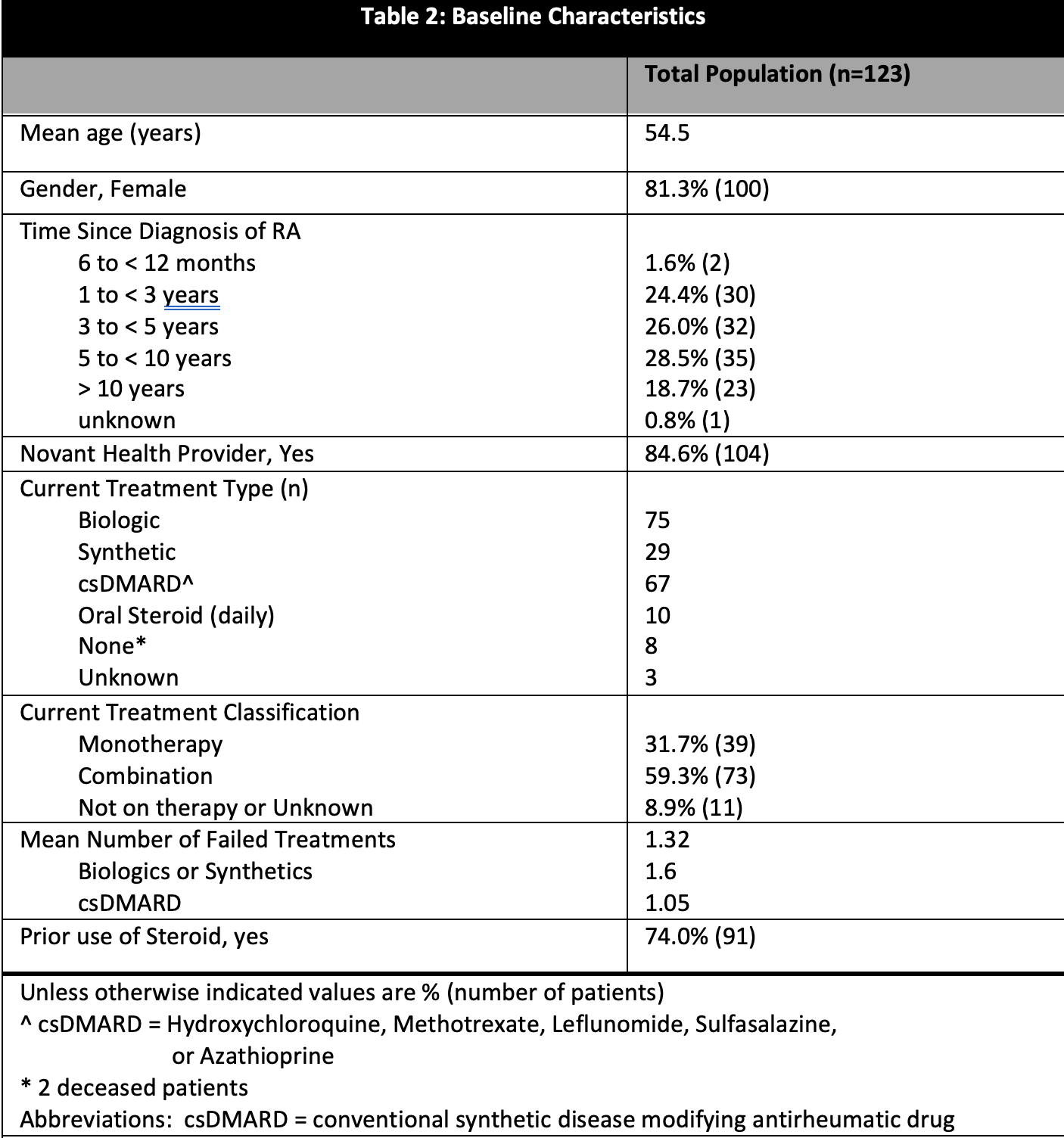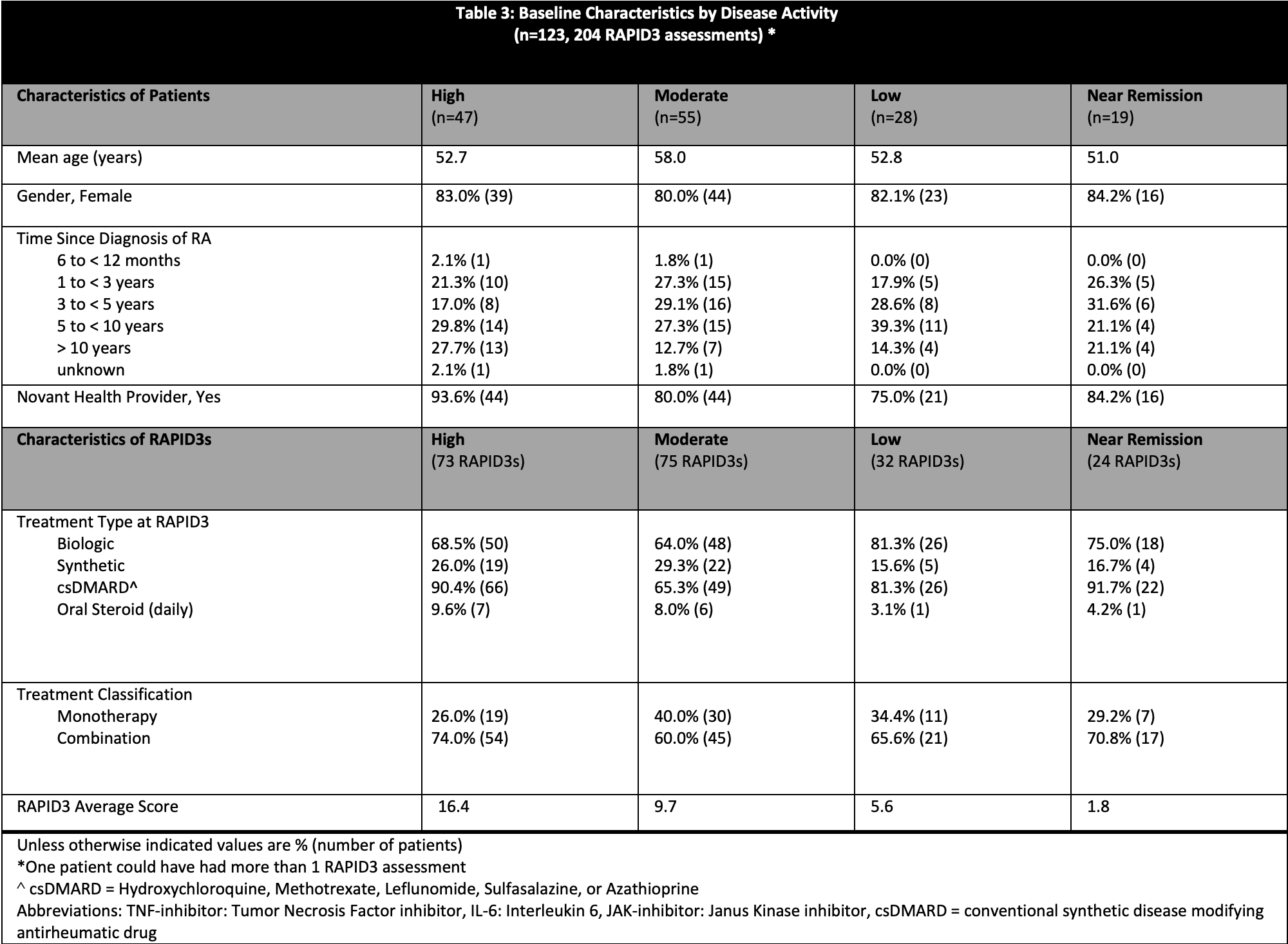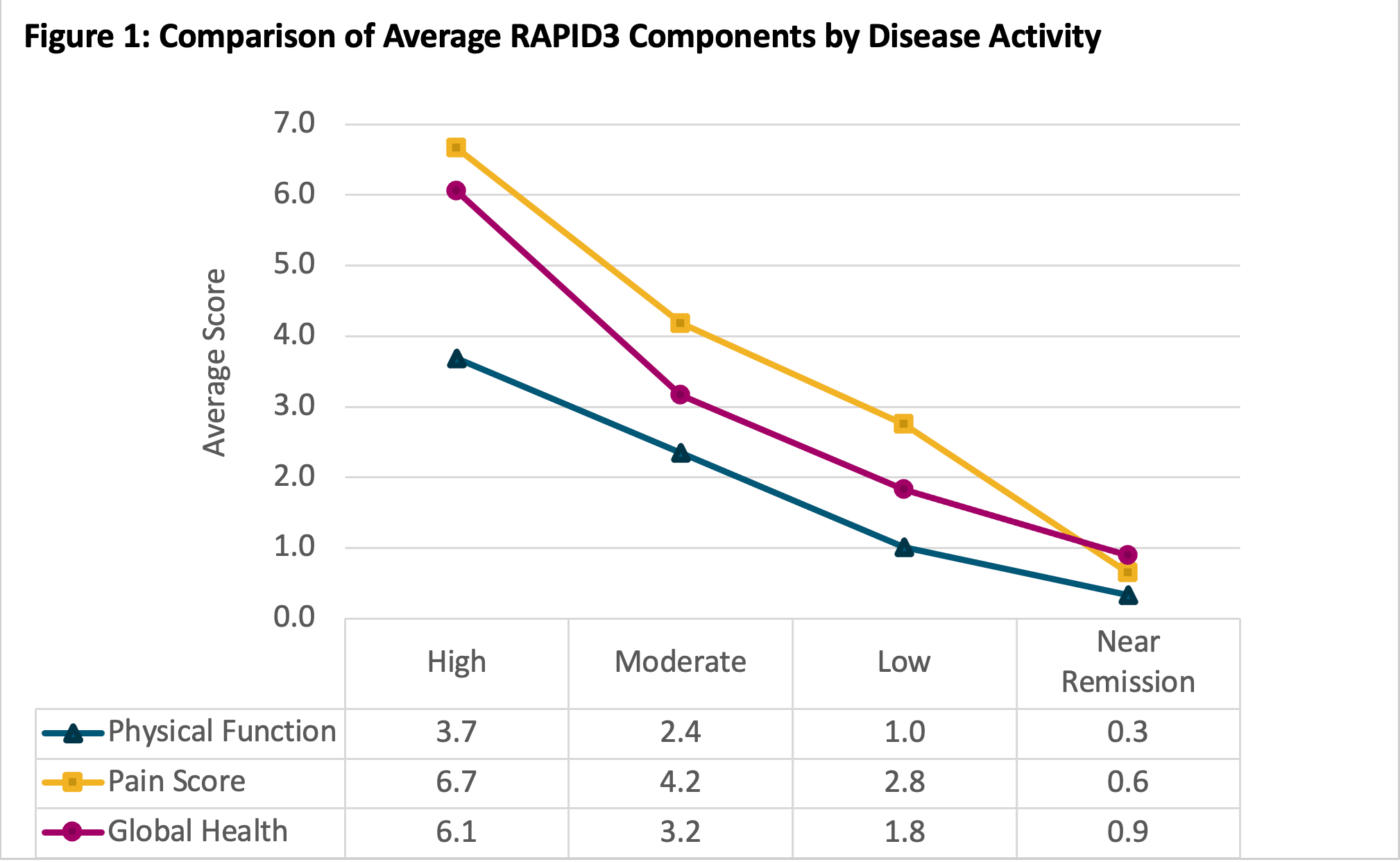Article
Evaluation of Factors Driving Rheumatoid Arthritis Moderate to High Disease Activity on Routine Assessment of Patient Index Data 3 Score
Utilization of the RAPID3 tool can be a beneficial way for pharmacists to complete disease activity assessments without physically seeing the patient in a clinic setting.
Introduction:
Rheumatoid arthritis (RA) is the most common type of autoimmune arthritis affecting approximately 1.3 million people in the United States.1,2 It is characterized by joint pain, stiffness, and swelling due to inflammation in the joint.1
Over time, RA can lead to joint destruction.1,3 Adequate treatment of RA involves proper evaluation, early diagnosis, and early management. The American College of Rheumatology (ACR) and European League Against Rheumatism (EULAR) both recommend a treat-to-target approach for optimal management of RA.3,4
According to the treat-to-target approach, therapy should be adjusted in patients who remain in moderate or high disease activity after 3 months until the desired treatment target of low disease activity or remission is achieved.3
In the treat-to-target approach, most treatment naïve patients with moderate to high disease activity are recommended to start on monotherapy methotrexate, a conventional synthetic disease-modifying antirheumatic drug (csDMARD). If the patient continues to have lack of improvement in their RA symptoms, patients may move on to dual therapy with other csDMARDs (leflunomide, sulfasalazine, or hydroxychloroquine), biologics, or Janus kinase (JAK) inhibitors. Triple therapy is also an option with csDMARDs, however, it is preferred to use methotrexate plus biologics or JAK inhibitors to achieve more rapid onset of benefit and better tolerability.3
To assess disease activity, the following instruments have been recommended by the ACR: Routine Assessment of Patient Index Data 3 (RAPID3), Simplified Disease Activity Index (SDAI), Clinical Disease Activity Index (CDAI), and Disease Activity Score 28 (DAS28).5 These tools are used in clinical practice to classify a patient’s disease activity as high, moderate, low, or near remission.
SDAI, CDAI, and DAS28 are all similar tools using both objective data (number of joints affected and pertinent inflammatory labs) and subjective data (pain score and quality of life) to classify disease activity. These tools require in-person office visits so the provider can complete a physical exam of the joints.
In contrast, the RAPID3 tool does not require an in-person assessment since the questions asked are all subjective. RAPID3 includes the patient’s assessment of their physical function, pain score, and global health.5
Although these instruments can be helpful in assessing a patient’s disease activity, there has been evidence to suggest that the treat-to-target approach is not always used as the standard in the United States.6,7 Gavigan et al. discussed possible barriers to therapy modification, including provider assessment of patient, patient self-assessment, and inaccuracy of the RAPID3 instrument.6
At Novant Health Specialty Pharmacy, our research team conducted a study further adding to this research.8 This study showed that not only was the treat-to-target approach not used for every patient, but also that the disease activity score documented in clinic, using CDAI, and the RAPID3 score were not well correlated.
Multiple studies have shown discrepancies between disease activity tools or between patient or provider assessments and instrument scores.6,8-10 Pincus et al. compared the RAPID3 instrument to DAS28 and CDAI.9 When comparing RAPID3 and CDAI scores, it was found that when CDAI reported high disease activity, 78% of those patients also had reported high disease activity via RAPID3.
When looking at moderate disease activity, only 36% of those patients had a correlating moderate disease activity via RAPID3.9 Inciarte et al. also investigated RAPID3 discrepancies when compared to DAS28 with Erythrocyte Sedimentation Rate (DAS28-ESR).10 They found that 61.7% of patients on tumor necrosis factor (TNF) inhibitor therapy and classified as near remission or low disease activity by DAS28-ESR had moderate to high disease activity via RAPID3. Study researchers found that the most self-reported factor that impacted disease activity was pain score.10
At Novant Health Specialty Pharmacy, clinical pharmacists (CPs) are embedded in rheumatology clinics within our health system. The CP is responsible for engaging in direct patient care to optimize medication therapy, provide patient education, and assess response to therapy.
CPs work with the Specialty Pharmacy Medication Therapy Management (MTM) platform, Therigy, to make initial and follow up calls with the patient. They use the RAPID3 tool during MTM phone calls to evaluate how RA patients respond to therapy.
Our previous findings8 have been consistent with the aforementioned literature showing that variances exist with this assessment tool. However, the RAPID3 instrument continues to be used by our CPs as it is the only ACR recommended tool that is quick, convenient, and able to be conducted outside of an office visit.11,12 The aim of this study is to identify RAPID3 components and classification of therapy that may influence moderate to high disease activity on the RAPID3 score.
Materials and Methods
Novant Health’s institutional review board approval was obtained for this study. A retrospective chart review was conducted on patients with RA who filled an RA-related medication at Novant Health Specialty Pharmacy (NHSP) between July 1, 2019, and July 31, 2021. For the study, 389 patients with RA who filled at NHSP and had a RAPID3 assessment documented within Therigy were identified.
Patients included were at least 18 years of age and had a completed RAPID3 follow up assessment. Patients were excluded if any of the following were missing: any component of the RAPID3 follow up assessment, baseline patient information, or RA medication name at the time of RAPID3. The specialty platform, Therigy, and electronic health record, EPIC, were both used to collect data on patient characteristics, treatment history for RA, RAPID3 score components at follow up, and medication use at RAPID3 follow ups.
The RAPID3 assessment has 3 components, including physical function, pain score, and global health. Each section is scored between 0 to 10 with a total RAPID3 score between 0 to 30, 30 being highest severity of disease activity and 0 being near remission. Questions included in the RAPID3 are shown in Table 1.

The primary endpoint of this study was to compare scored components (physical function, pain score, global health) of RAPID3 based on level of disease activity. A secondary endpoint explored the differences between monotherapy and combination therapy of scored components of the RAPID3 assessment. Averages of scores were used for comparison for both endpoints. Data analysis was conducted utilizing descriptive statistics.
Results
Patient Characteristics
A total of 123 patients with 204 completed RAPID3 follow up assessments were included. The average patient age was 54.5 years and 81.3% of patients were female (Table 2).

Time since diagnosis of RA varied with most patients diagnosed either between 1 to 3 years ago (24.4%), 3 to 5 years ago (26.0%), or 5 to 10 years ago (28.5%). The mean number of failed treatments was 1.32. Ninety-one patients (74.0%) had a history of oral steroid use to treat RA. Baseline characteristics were also stratified by disease activity (Table 3).

Baseline characteristics of age and sex were similar across subgroups. Average RAPID3 total score was 16.4 for high disease activity, 9.7 for moderate disease activity, 5.6 for low disease activity, and 1.8 for near remission. Most patients were on combination therapy at time of RAPID3 assessment, regardless of disease activity. The most common medication classes were biologics and csDMARDs across all subgroups.
RAPID3 Scores Based on Level of Disease Activity
The primary endpoint compared RAPID3 component scores based on level of disease activity, with 73 RAPID3s included in the high disease activity group, 75 in the moderate disease activity group, 32 in the low disease activity group, and 24 in the near remission group. Figure 1 shows the comparison of average physical function, pain score, and global health components stratified by disease activity.

In the high disease activity group, the highest scored RAPID3 components were pain score (mean of 6.7), closely followed by global health (mean of 6.1). This trend was similar in both moderate disease activity and low disease activity groups, with the highest scored RAPID3 component of pain score (mean of 4.2 and 2.8 respectively).
Physical function averages were the lowest regardless of disease activity. Breakdown of average score by individual function questions are shown in Figure 2. Question 1i (ability to walk 2 miles) and question 1j (participation in recreational activities and sports) had the highest averages across all disease activities.

RAPID3 Scores Based on Combination or Monotherapy
The secondary endpoint analyzed RAPID3 component scores when stratified by therapy classification. Combination therapy was used at the time of 148 total RAPID3 follow up assessments. Comparison of average physical function, pain score, global health, and total RAPID3 score between combination and monotherapy were very similar (Table 4).

Total RAPID3 score average was 10.6 in the combination therapy group and 10.3 in the monotherapy group. Highest average component was pain score for both combination (mean of 4.5) and monotherapy (mean of 4.3) groups, followed closely by global health (mean of 3.8 and 3.5 for combination and monotherapy groups respectively).
Discussion
Utilization of the RAPID3 tool can be a beneficial way for pharmacists to complete disease activity assessments without physically seeing the patient in a clinic setting. However, prior research shows variances between the RAPID3, other instruments, patient perception, and provider evaluation. Given these variances, this study aimed to identify factors that may influence moderate to high disease activity.
The results of this retrospective study show that higher pain score and global health components are correlated with higher disease activity on the RAPID3 tool compared to physical function. The average pain score was the highest scored category in the high, moderate, and low disease activity groups and second highest scored category in the near remission group.
The global health score averages followed closely behind and was the second highest scored category for the high, moderate, and low disease activity groups. Additionally, it was found that physical function had the least contribution to higher disease activity.
Within the physical function questions, 1i and 1j had the greatest impact on disease activity. As the highest scored component on the RAPID3 were pain score and global health these are the predominant factors leading to moderate to high disease activity when using the RAPID 3 tool.
When comparing the results between combination and monotherapy, average scores were very similar amongst all components of the RAPID3. Highest average was found in the pain score component for both combination and monotherapy groups, followed closely by global health score, similar to the results shown when stratified by disease activity.
Our study had several limitations, one of them being the retrospective study design. There was no control group or comparator instrument for this study.
Also, a fewer number of RAPID3 assessments with low or near remission disease activity and monotherapy therapy classification were included for comparison. Additionally, there were some data collection inconsistencies with patients seen by non-Novant Health providers as data from our EPIC electronic medical record were limited.
Overall, the results show that moderate to high disease activity on the RAPID3 tool is driven by high pain score and global health components. Given the large impact of pain score and global health on perceived disease activity when using the RAPID3, further studies are needed to determine the best way to utilize the RAPID3 tool. Creating a better method to effectively use the RAPID3 tool to aid in treatment optimization will enhance patient outcomes.
References
- Duarte-Garcia A. Rheumatoid arthritis. Rheumatology.Org. https://www.rheumatology.org/i-am-a/patient-caregiver/diseases-conditions/rheumatoid-arthritis. Published March 2019.
- Hunter, T.M., Boytsov, N.N., Zhang, X. et al. Prevalence of rheumatoid arthritis in the United States adult population in healthcare claims databases, 2004–2014. Rheumatol Int 37, 1551–1557 (2017). https://doi.org/10.1007/s00296-017-3726-1
- Fraenkel L, Bathon JM, England BR, et al. 2021 American College of Rheumatology guideline for the treatment of rheumatoid arthritis. Arthritis Care &Amp; Research. 2021;73(7):924-939. Doi:10.1002/acr.24596
- EULAR 2019: Smolen JS, Landewé RBM, Bijlsma JWJ, et al. EULAR recommendations for the management of rheumatoid arthritis with synthetic and biological disease-modifying antirheumatic drugs: 2019 update. Annals Of The Rheumatic Diseases 2020;79:685-699.
- England BR, Tiong BK, Bergman MJ, et al. 2019 Update of The American College of Rheumatology Recommended Rheumatoid Arthritis Disease Activity Measures. Arthritis Care &Amp; Research. 2019;71(12):1540-1555. Doi:10.1002/acr.24042
- Gavigan, K., Nowell, W.B., Serna, M.S. Et al. Barriers to treatment optimization and achievement of patients’ goals: perspectives from people living with rheumatoid arthritis enrolled in the arthritis power registry. Arthritis Res Ther 22, 4 (2020). https://doi.org/10.1186/s13075-019-2076-7
- Yun H, Chen L, Xie F, Patel H, Boytsov N, Zhang X, Curtis JR. Do patients with moderate or high disease activity escalate rheumatoid arthritis therapy according to treat-to-target principles? Results from the rheumatology informatics system for effectiveness registry of the American college of rheumatology. Arthritis Care Res (Hoboken). 2020 feb;72(2):166-175. Doi: 10.1002/acr.24083. Pmid: 31566905.
- Godley, E., Chang, J., Cardwell, LM., Impact of pharmacist conducted routine assessment of patient index data 3 (RAPID3) assessments on therapy modification in rheumatoid arthritis. Poster presented at ASHP midyear conference; December 2021; virtual.
- Pincus Theodore, Swearingen Christopher, Bergman Martin, Yazici Yusuf. RAPID3 (Routine Assessment of Patient Index Data 3), a Rheumatoid Arthritis Index Without Formal Joint Counts For Routine Care: Proposed Severity Categories Compared to Disease Activity Score and Clinical Disease Activity Index Categories. The Journal of Rheumatology. 2008;35(11):2136-2147. Doi:10.3899/jrheum.080182
- Inciarte-Mundo J, Morlà R, Frade-Sosa B, et al. Discrepancies Between RAPID3 and DAS28 In Rheumatoid Arthritis Patients in Remission or Low Disease Activity Receiving TNF Inhibitors: What is the Role of the Inflammation Biomarkers? [Abstract FRI0042] Ann Rheum Dis 2020;79:596.
- Pincus T, yazici Y, bergman MJ. RAPID3, an index to assess and monitor patients with rheumatoid arthritis, without formal joint counts: similar results to DAS28 and CDAI in clinical trials and clinical care. Rheum Dis Clin North Am. 2009 nov;35(4):773-8, viii. Doi: 10.1016/j.Rdc.2009.10.008. Pmid: 19962621.
- Ward MM, Castrejon I, Bergman MJ, Alba MI, Guthrie LC, Pincus T. Minimal clinically important improvement of routine assessment of patient index data 3 in rheumatoid arthritis. The journal of rheumatology. 2018;46(1):27-30. Doi:10.3899/jrheum.180153
Newsletter
Stay informed on drug updates, treatment guidelines, and pharmacy practice trends—subscribe to Pharmacy Times for weekly clinical insights.






